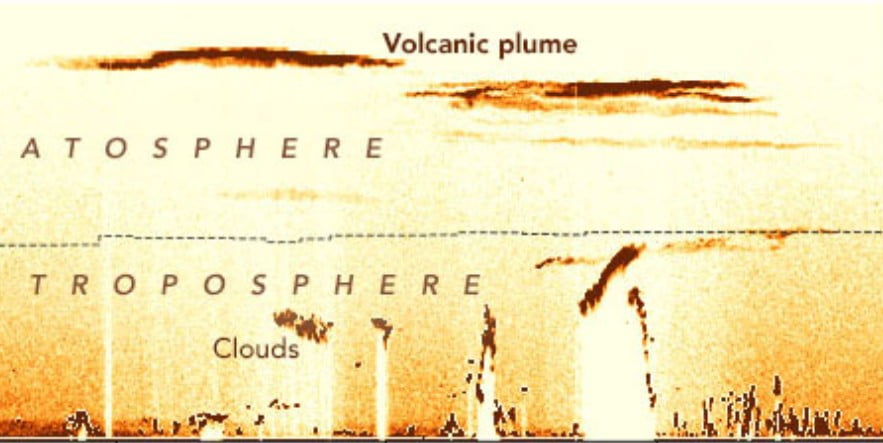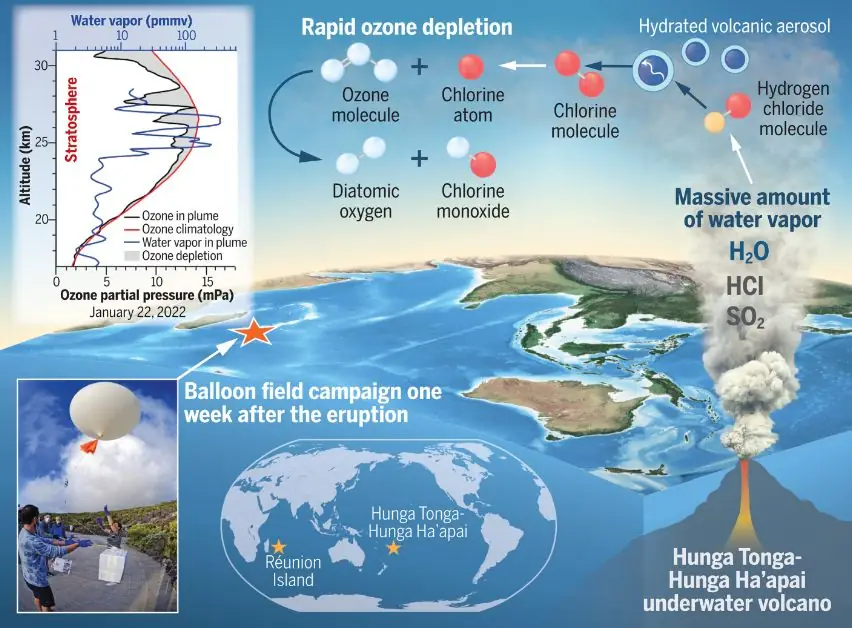Research reveals Hunga Tonga’s eruption caused an unexpectedly large loss of ozone

The January 15, 2022, eruption of the Hunga Tonga-Hunga Ha’apai volcano produced the largest underwater explosion ever recorded, injecting an unprecedented amount of water vapor into the stratosphere, causing significant ozone loss and rapid aerosol formation, according to recent studies.
The Hunga Tonga-Hunga Ha’apai volcano’s eruption has been identified as the largest underwater explosion on record. Recent research papers have detailed the immediate and profound effects of the eruption’s water vapor on Earth’s stratosphere, located between 16 and 50 km (10 and 31 miles) above the surface. These effects include an unexpectedly large loss of ozone and a rapid formation of aerosols, challenging previous understandings of volcanic eruptions’ impact on the atmosphere.
Elizabeth Asher, a CIRES research scientist now at NOAA’s Global Monitoring Laboratory, led one of the pivotal studies. “Up until now, sulfur has been the primary focus of research on eruptions,” said Asher. “Studying Hunga Tonga showed that other gases, like water vapor, can have a profound impact on these outcomes.” The eruption offered a unique opportunity to observe the immediate atmospheric impacts of a massive volcanic event.

When news of the eruption broke, Karen Rosenlof, a senior climate scientist at the Chemical Sciences Laboratory, mobilized a team to La Réunion, an island in the Indian Ocean 12 875 km (8 000 miles) from Hunga Tonga.
Within days, researchers equipped with miniaturized atmospheric instruments boarded flights to the island. Their rapid deployment of balloon-borne observations confirmed the staggering 150 million tons of water vapor injected into the stratosphere by the eruption. Alongside measuring ozone and sulfur dioxide, a portable optical particle spectrometer (POPS) instrument determined the abundance of injected aerosol and the rate of new aerosol particle formation downwind of the volcano.
The rapid response by NOAA and partner scientists led to vital insights into stratospheric changes. “Our measurements showed that stratospheric ozone concentrations decreased rapidly – by as much as 30% in air with the highest water vapor concentrations – in the immediate wake of the eruption,” stated Stephanie Evan, a scientist from the Laboratoire de l’Atmosphère et des Cyclones in France.
While Evan’s study focused on ozone impacts, Asher concentrated on volcanic aerosols’ global climatic effects. By combining balloon data with global satellite data, the team observed a large, dense layer of aerosol particles forming in the stratosphere faster than ever before, a rapid production prompted by the massive water vapor injection.
The 1991 Mt. Pinatubo eruption, which cooled the planet by approximately 0.3°C (0.5°F), underscored volcanic aerosols’ climatic importance. Hunga Tonga’s eruption has provided critical clues for understanding the chemical and microphysical processes in aerosol formation.
These findings not only advance scientific knowledge about stratospheric aerosol processes but also inform discussions on climate intervention strategies, such as stratospheric aerosol injection.
References:
1 A volcanic eruption sent enough water vapor into the stratosphere to cause a rapid change in chemistry – NOAA Research – December 20, 2023
Featured image credit: TR2Ex

Commenting rules and guidelines
We value the thoughts and opinions of our readers and welcome healthy discussions on our website. In order to maintain a respectful and positive community, we ask that all commenters follow these rules.